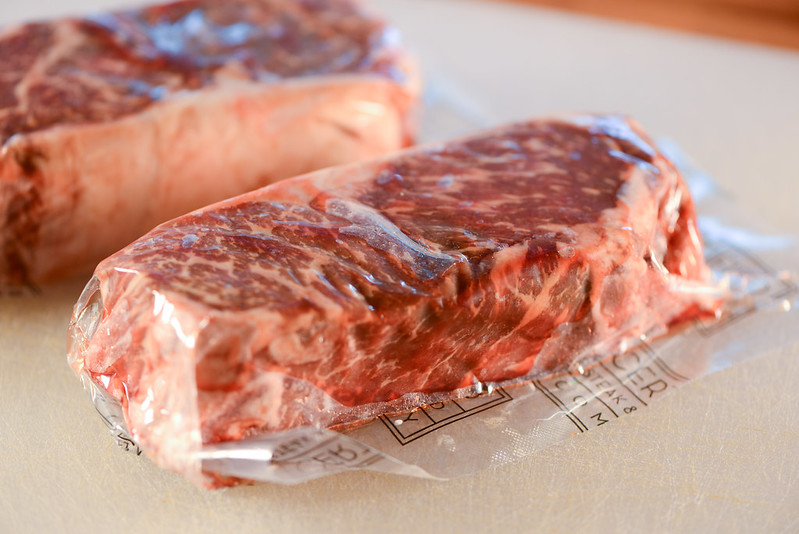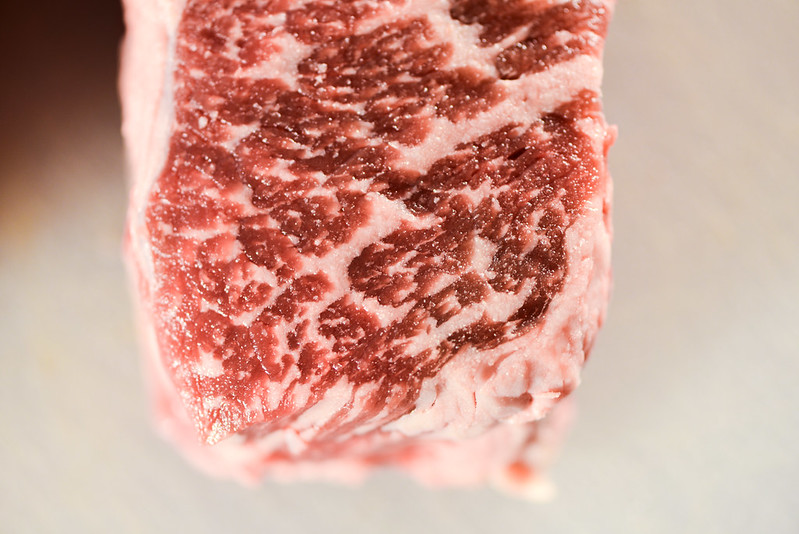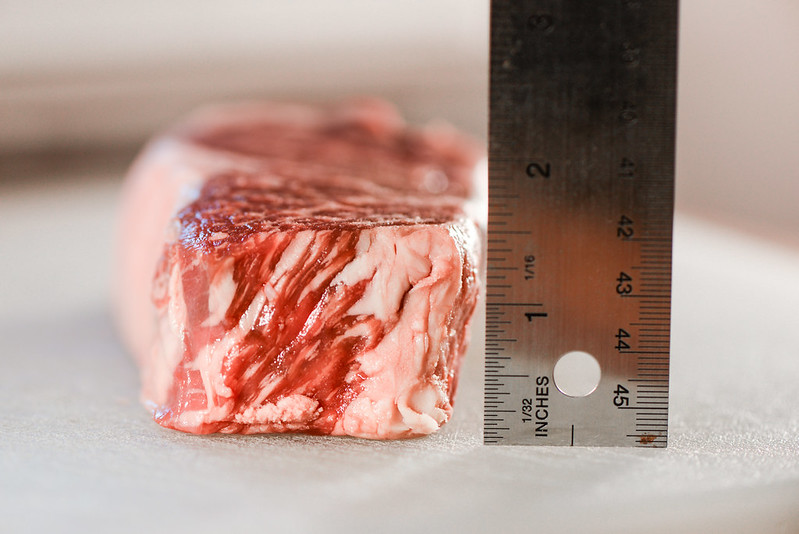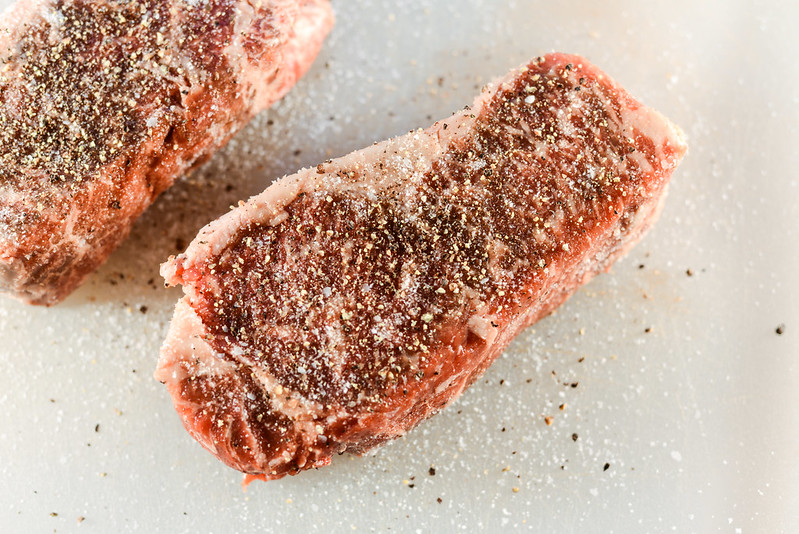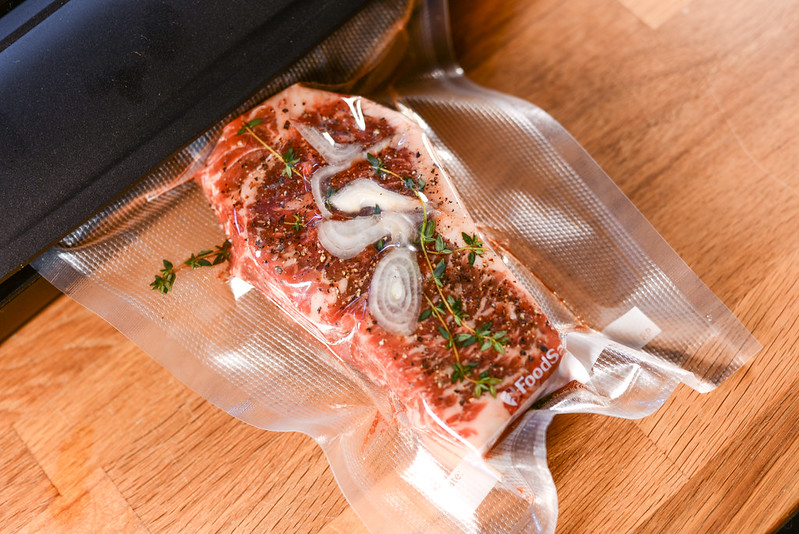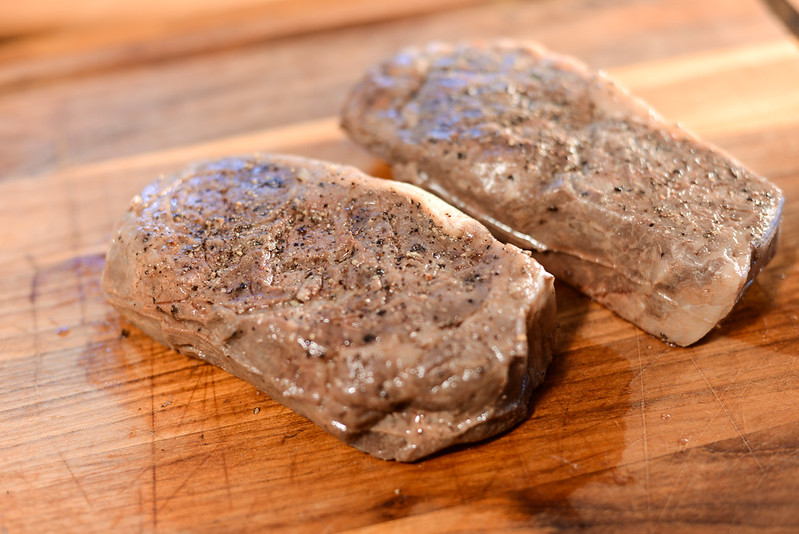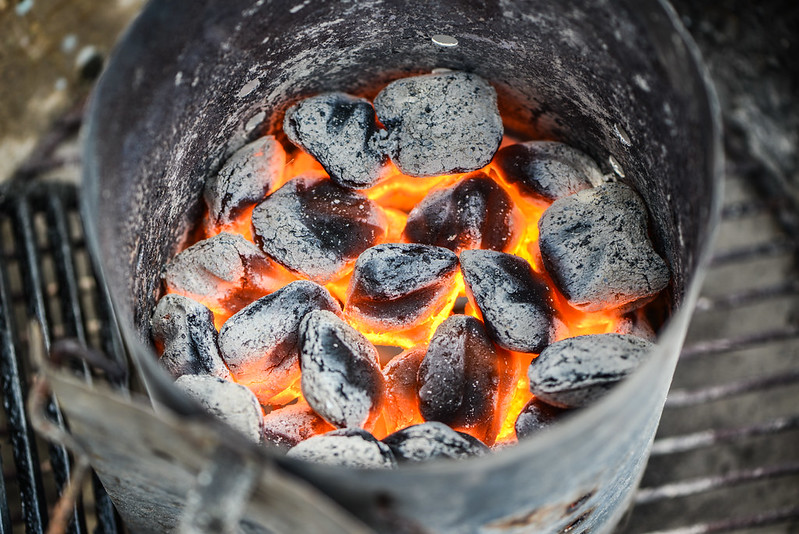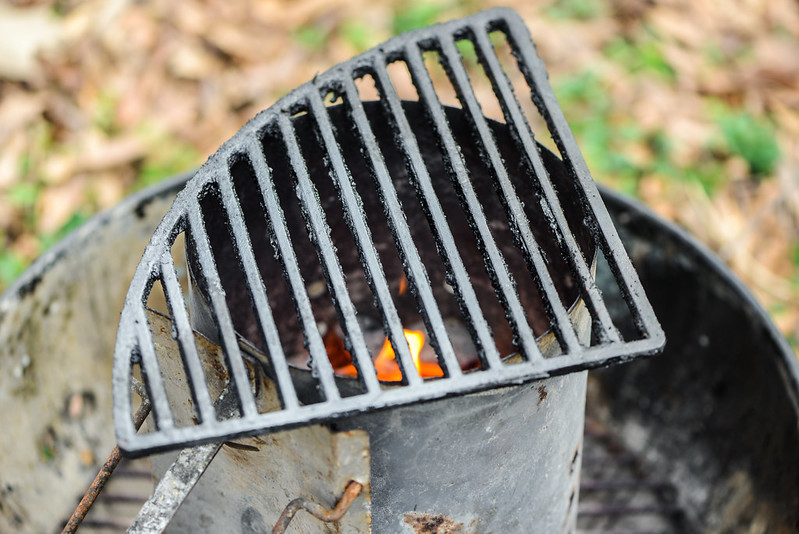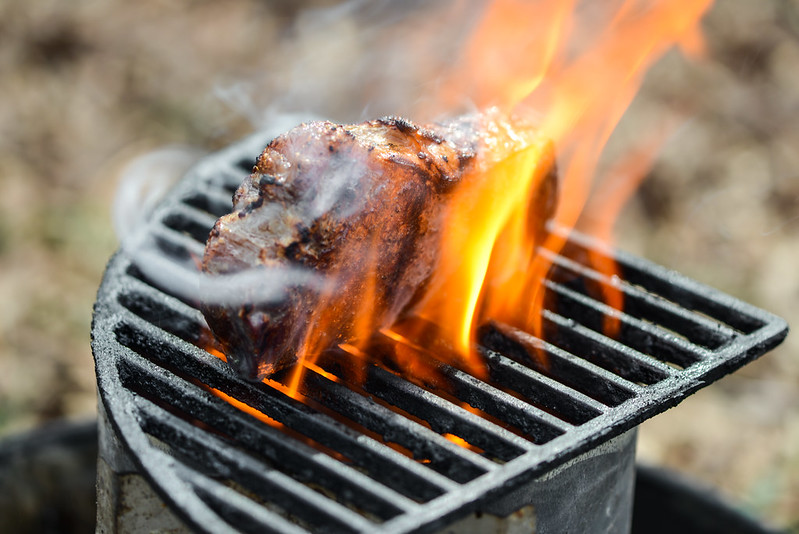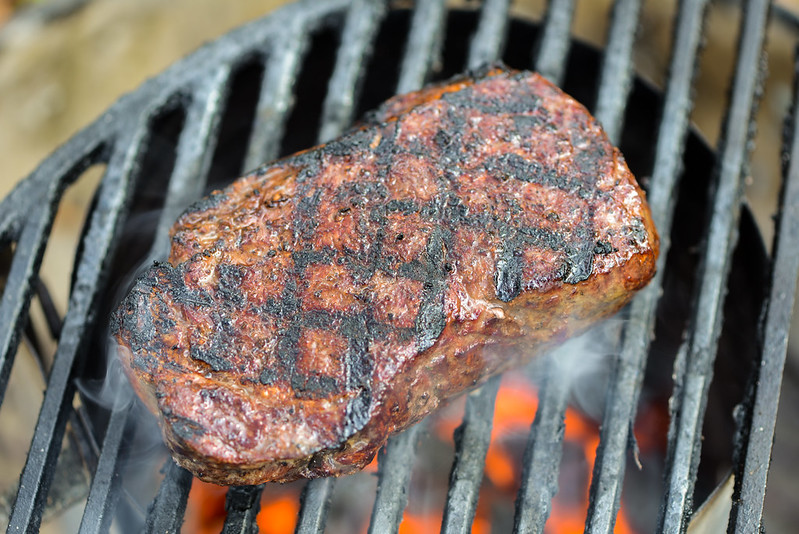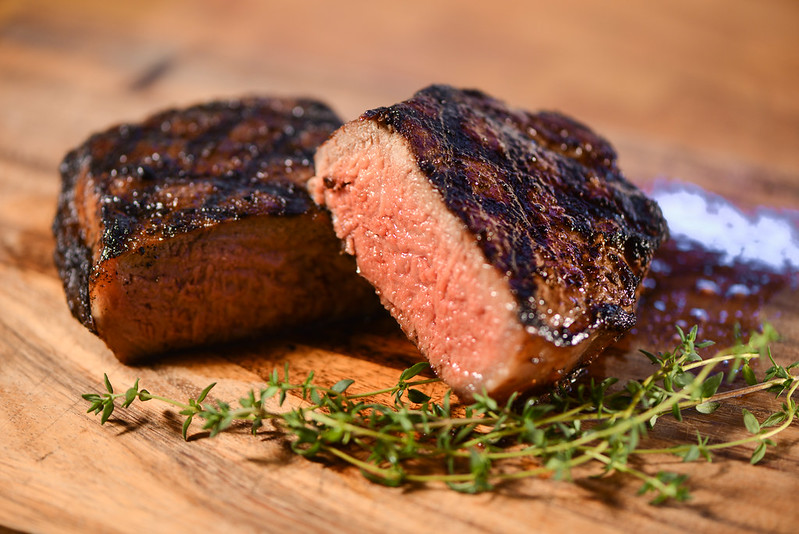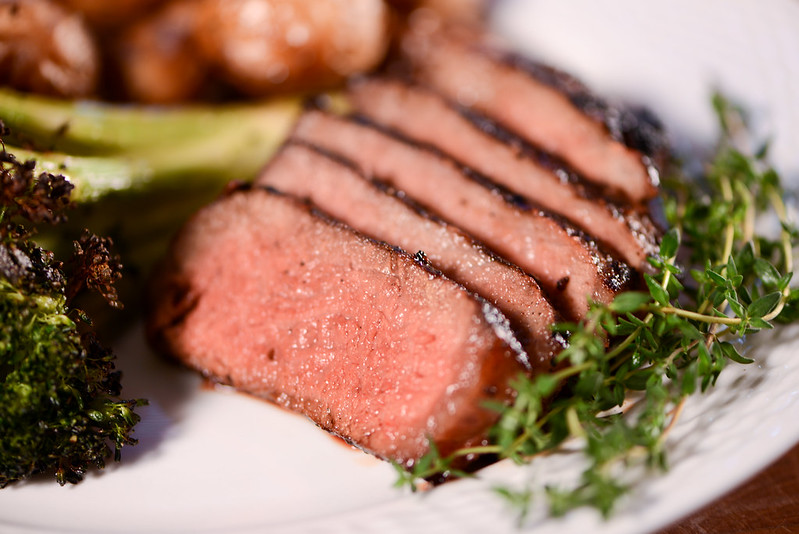Sous Vide and Grilled NY Strip Steaks
I'm not one to buy into kitchen gadgets—I try keep my collection of tools and cookware to the essentials. I always classified immersion circulators in that "gadget" category, thinking they were something I really didn't need to cook well and likely wouldn't even use if I did own one. Then a couple years ago, there was a Kickstarer for the Anova Precision Cooker, which brought along with it a pathway to own a quality circulator for a reasonable price and I bought in on impulse. Although I was initially excited when the device came in the mail in Nov of 2014, my instincts were right—I didn't see it as necessity to cook, and therefore it sat untouched for a long time. I decided it was time to change that and have recently starting to experiment with the circulator and the results are beginning to sway my opinion on sous vide being relegated to second string in my cooking arsenal, I mean just look at these gorgeous New York strips that I cooked in a water bath, then finished over the flames.
Of course, I can't give sous vide all the credit for these incredible steaks, they started out with some quality meat. I procured two dry aged New York strips from the Certified Steak and Seafood Company in a trade for rights to use an image of mine on their site. I'm usually wary of mail order steaks because it doesn't afford the ability to see what I'm buying like at a butcher, but what I received on dry ice from this company has left me with a lot of faith in their products.
If I were choosing strips myself, first and foremost, I want excellent marbling in the meat. These steaks outdid what I would find at an average butcher with plentiful intramuscular fat. This fat equates to both flavor and better cooking qualities since it helps keep the steak's temperature from rising too fast, although that's not really a concern if cooking them sous vide.
Second thing I'd want in my steak is for it to be thick, and the two strips I got came in with a good one-and-half inch thickness. The thick steak is another step to prevent overcooking—skinny cuts just cook too fast, making them easy to over do and dry out. Because I was planning on finishing my steaks over some high heat, I wanted them plenty thick to avoid accidentally cooking them past my desired medium-rare.
Totally happy with the meat, I went fort with the cooking. This started the same way I prep all my steaks, with a liberal coating of salt and pepper.
Then I placed each of the steaks in its own bag and added in a couple springs of thyme and slices of shallots on the top and bottom of each steak. When cooking steaks stovetop, I usually use thyme and shallots as aromatics in the last step of cooking and I wanted to try and bring in a bit of that subtle flavor here as well. Once I had all the contents of the bags in place, I vacuumed sealed them. If you don't have a vacuum sealer, don't worry, you can cook these in Ziploc bags sealed by lowering the bags into the water bath, then sealing them shut right when just the top of the bag is above the water line.
One tricky thing with choosing sous vide here was selecting the right temperature. See, one steak was for me, and I prefer a rare to medium-rare doneness, and the other was for my wife, who likes her steak a little closer to medium. On the grill that's not problem, just cook one steak longer than the other, but with sous vide, I had to select one temperature and go for it (unless I wanted to cook the steaks separately). That left choosing a temperature of 133°F, which is a little higher than I would go for myself, and little lower than I would go for my wife.
With the immersion circulator running at my desired temperature, I lowered the bags into the water bath and let them cook for two hours. You can go as little as one hour and as much as four with these, but pushing it beyond four hours could start to make your meat a bit mushy.
After they were done, the steaks came out of the bags looking like this—appetizing, right? Sous vide steaks may be an easy pathway to perfect doneness and tenderness, but what good is a steak without a crusty sear? That's just as important to the flavor and texture of a perfect steak as the juicy, beefy meat in my opinion.
So this brought up the question, how do you get a great sear on a sous vide steak without raising the temperature of the meat beyond the perfect doneness already achieved? I think one of best answers lies with the grill—specifically with charcoal that can get incredibly hot.
No charcoal heat is quite as intense as the heat outputted when lit coals are together in a chimney. This mixture of concentrated coals and good airflow make it incredibly hot, and I saw this as a perfect way to sear my steaks as fast as possible. So with a chimney about 1/3 filled with lit coals, I took a panel out of my cast iron grilling grate and rested it atop the chimney.
I then cooked one steak at a time (although there was room to do two at once) over this scorching hot fire. While cooking, I continually flipped the steaks every 20 seconds or so to keep them cooking evenly. I inevitably got some flare ups as fat rendered and hit the coals, but never had any sustained fires that would have killed my steaks. I know the photos may make it look a little deceiving, but don't those orange towers of fire kissing the steak just look pretty?
Especially here, where I finished my sear by getting the sides of the steak browned, and that layer of pure fat that was facing the fire created a short, but big burst of fire.
Most of the time the cooking actually looked like this, smoky, but not fiery. I got fancy with my steaks and gave them a pretty crosshatch pattern which you can do by positioning the steak at a 45° angle with the grates, sear, rotate the steak 90° and sear again.
Sous vide steaks don't need to rest before slicing, which is a good thing because I couldn't wait to eat mine. I made the first slice and was greeted with a nice rosy red interior pretty much from edge to edge—something that's more difficult to achieve cooking steaks on the grill or stovetop only.
The meat was incredibly tender, albeit not as juicy as I would have liked. They ended up with a doneness better suited for my wife's tastes than my own, although she commented she would even like these a little more rare next time. I was really happy with the sear, even if it wasn't as crusty as it would have been if I had cooked it on the grill only. So going sous vide represented a couple trade offs, a slightly less than ideal sear for one of the most tender steaks I've ever cooked that was perfectly medium-rare from edge to edge. It certainly left me impressed and ready to take my immersion circulator out of the useless gadget category and find ways to incorporate more regularly into my cooking process.
You Might Also Like
Comments
-
The Boys @ Grillin%u2019and Chillin%u2019 This an awesome recipe! I would love to try this myself as well. Thanks for sharing.
-
Bernard Meenaghan Try grilling steaks right out of the freezer. Must be 1.5 in. thick. Juicy, delicious. No need for Sous Vide.
-
alexferdenz Josh, It looks very delicious grill to me. I will try for sure. However, I have just started a blog healthyceramiccookware.com/. And it is related to cooking(like yours). Like to get your feedback.
-
Mike I have never tried using my sous vide for cooking the internal temp first. (I have the exact same one you used) I guess I was reluctant to not grill it the entire way. Turned out amazing. www.bbqgrillshops.com

